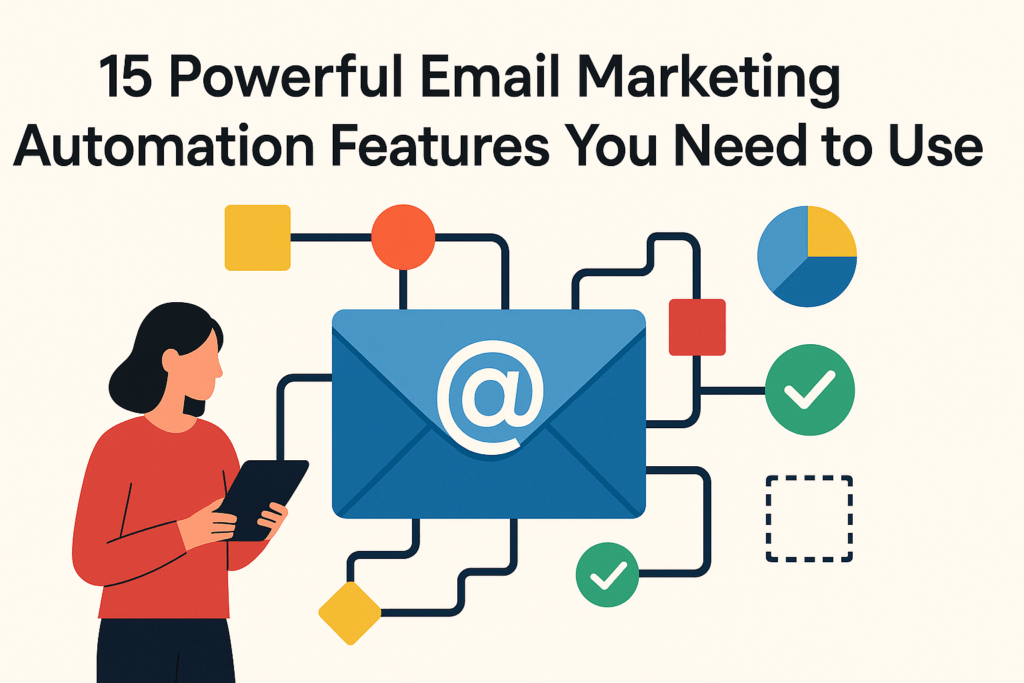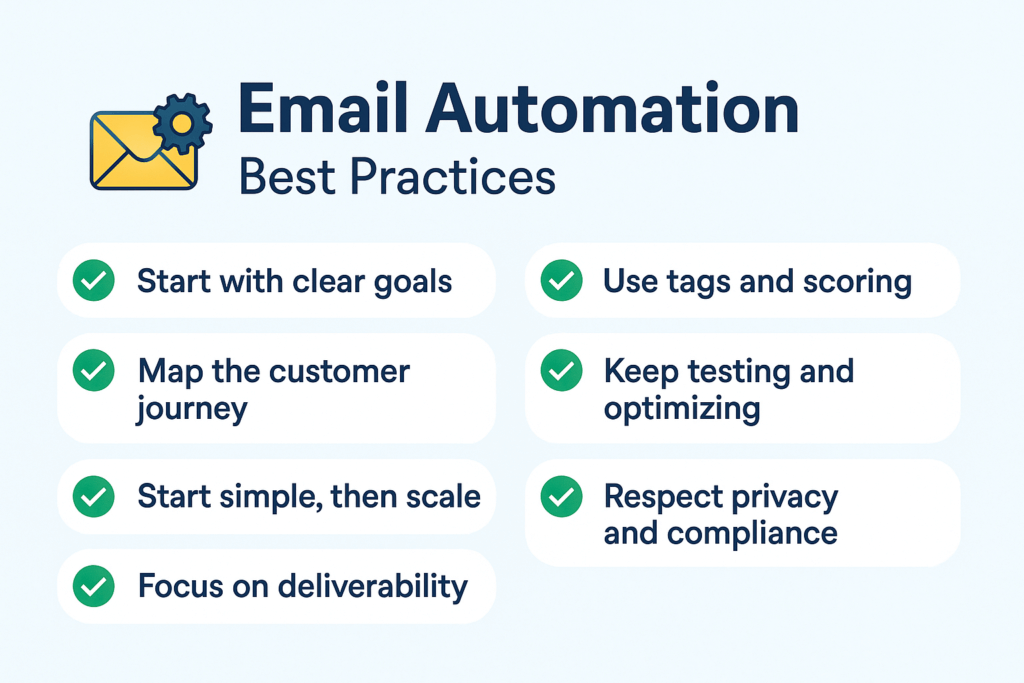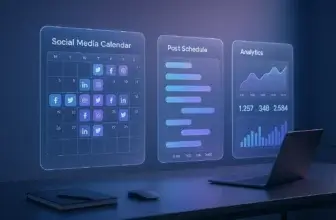
Email marketing has come a long way from simply blasting messages to everyone on your list. With automation, you can create smart, behavior-driven campaigns that engage your audience on a personal level, without burning out your marketing team. 🚀
In this guide, you’ll explore the most powerful email marketing automation features and how to use them to build deeper relationships, drive more conversions, and scale your email strategy efficiently.
Let’s dive in.
What Is Email Marketing Automation?
Email marketing automation refers to using software to automatically send emails based on predefined triggers, schedules, or user behaviors. Instead of manually crafting and sending every email, you create workflows that run on autopilot, while still feeling personalized to each subscriber.
Here’s what it lets you do:
- Automatically welcome new subscribers
- Nurture leads with drip sequences
- Retarget users based on their behavior
- Re-engage dormant contacts
- Deliver content exactly when it’s needed
Whether you’re a startup or a growing SaaS, automation is the secret to making your email program efficient and effective.
💡 Curious about which platforms offer these capabilities? Check out our best email marketing tools to see which one fits your needs.
🚀 Why Automation Is Crucial in Modern Email Marketing
If you’re still sending one-size-fits-all emails to your entire list, you’re leaving conversions and revenue on the table. Automation allows you to be strategic, timely, and relevant in every message you send.
Here’s why email marketing automation is a game-changer:
1. Saves Time and Resources
Once you’ve set up your workflows, they run 24/7. You’re no longer tied to your inbox or scheduling tool every day.
2. Increases Engagement Through Personalization
You can tailor messages based on where someone is in their journey, welcoming new subscribers, educating leads, or rewarding loyal customers.
3. Boosts Revenue and ROI
According to DMA, marketers see a 4200% ROI, $42 for every $1 spent on email marketing. Automation only amplifies this by delivering the right message at the right time.
4. Enables Scalable Growth
Whether you’re emailing 1,000 or 100,000 people, your system can handle it, without extra manual work.
5. Provides Real-Time Insights
You’ll know which workflows convert, where users drop off, and what emails perform best, so you can continuously optimise.
Core Email Marketing Automation Features
Ready to supercharge your email campaigns? 🚀
Below is a quick overview of the 15 essential email automation features every marketer should be using. Each one solves a specific problem – from lead nurturing to list hygiene – and when used together, they create a high-performing email engine.
📋 Overview: Email Automation Features at a Glance
| Feature | Primary Purpose | Impact |
|---|---|---|
| Welcome Sequences | Engage new subscribers | Higher early engagement 📈 |
| Drip Campaigns | Nurture leads over time | Better conversions 🔄 |
| Behavior-Based Triggers | React to user actions in real-time | More relevant messaging ✉️ |
| Advanced Segmentation | Group users by behavior or traits | Increased personalization 🧠 |
| A/B Testing | Optimize content through experiments | Higher open/click rates 🧪 |
| Personalization Tokens | Add dynamic user data to emails | Stronger connection 💬 |
| Dynamic Content Blocks | Customize email sections per segment | Smarter personalization 🧩 |
| Email Retargeting | Win back engaged users | Reduced churn 🔁 |
| Time Zone Optimization | Deliver at the perfect time | Increased engagement ⏰ |
| Contact Scoring & Tagging | Qualify leads automatically | Better targeting 🎯 |
| CRM Integration | Sync marketing and sales data | Improved alignment 🧷 |
| Multi-Channel Automation | Coordinate across SMS, ads, and email | Cohesive campaigns 📡 |
| Real-Time Analytics | Monitor email performance instantly | Smarter decisions 📊 |
| Re-engagement Campaigns | Revive inactive contacts | List cleanliness ✅ |
| AI-Powered Content Suggestions | Enhance creativity and content quality | Faster email production 🤖 |
Let’s explore each one in more detail:
1. Automated Welcome Sequences
A welcome email (or better, a series) is your opportunity to create an instant connection. It shows subscribers they made the right decision joining your list. Introduce your brand, offer value (like a discount or freebie), and set expectations for what’s to come.
Tip: The best tools like Moosend or Klaviyo, make it easy to build multi-step welcome flows.
2. Drip Campaigns
Drip campaigns deliver educational, promotional, or onboarding content over time. They’re perfect for guiding users through the customer journey. You don’t have to sell right away; start with insights, build trust, then convert.
Use Case: For SaaS, drip emails might include tutorials, feature highlights, and a case study before pushing for a trial upgrade.
3. Behavior-Based Triggers
Automation shines brightest when it’s contextual. With behavior-based triggers, you can send emails based on what users actually do, such as abandoning a cart, browsing specific pages, or clicking an email link.
Examples:
- “Still interested?” follow-ups
- Cross-sell based on past purchases
- Event reminders or confirmations
You can read our Campaigner review to see how this tool uses triggers effectively, or try Campaigner directly.
4. Advanced Segmentation
You’re not sending emails to a monolith. Advanced segmentation lets you tailor content for specific user groups, such as:
- Loyal customers
- First-time buyers
- Highly engaged vs. cold leads
Platforms like Brevo excel at segmentation with intuitive visual editors and CRM syncing.
5. A/B Testing
What’s the best way to improve your campaigns? Test them! With A/B testing, you can try two versions of subject lines, headlines, layouts, or CTAs, then let the winner run automatically.
This is a data-backed way to find out what truly resonates with your audience.
6. Personalization Tokens
Go beyond “Hi there” with tokens that dynamically insert subscriber data like:
- First name
- Job title
- Last item viewed
It makes your emails feel like personal messages rather than mass blasts, boosting trust and engagement.
7. Dynamic Content Blocks
Dynamic blocks allow different users to see different content in the same email. For instance, show a discount to new users and an upgrade CTA to premium ones, without building two emails.
It’s personalization at scale – without the extra workload.
8. Email Retargeting
Bring users back into your funnel by retargeting them via email after:
- Visiting a product page
- Adding items to cart
- Downloading a freebie
Sync with ad platforms to expand the reach of your automated retargeting strategy.
9. Time Zone and Send Time Optimization
Timing matters. The right automation tools can send emails when your subscribers are most likely to engage, based on location or behavioral data.
Example: If someone in NYC opens most of their emails at 8 AM, your automation will match that schedule. 🕗
10. Contact Scoring and Tagging
Automation isn’t just about sending emails; it’s also about organizing your list behind the scenes. Lead scoring assigns points based on user behavior, helping you identify hot leads. Tags let you group users by interest or actions taken.
This helps with prioritizing sales follow-up and refining future targeting.
11. CRM Integration
Your email tool should talk to your CRM. Whether you’re using HubSpot, Pipedrive, or monday.com, syncing data helps marketing and sales stay aligned, so no leads slip through the cracks.
monday.com is especially powerful here, offering visual automation workflows tied directly to contact data and deal stages.
12. Multi-Channel Automation
Email is just one piece of the puzzle. You can automate messages across:
- SMS
- Push notifications
- Facebook or Google retargeting ads
Multi-channel automation ensures that no matter where your users are, you can reach them effectively, without spamming.
13. Real-Time Analytics
Modern tools offer real-time data dashboards where you can track:
- Open rates
- Click rates
- Conversions
- List growth
Analytics help you refine and optimize your automation strategy continuously.
14. Re-engagement Campaigns
Your list will go stale over time. That’s why re-engagement campaigns are crucial. These emails are designed to:
- Win back inactive users
- Offer fresh incentives
- Ask if subscribers still want to stay
- If no response, it’s time to clean the list for better deliverability.
See how Mailchimp handles list cleaning with automation in our review.
15. AI-Powered Content Suggestions
Don’t know what to write? Some platforms now include AI assistants to:
- Suggest headlines
- Rewrite sections for clarity
- Create entire emails based on goals
It’s a massive time-saver, especially for small teams or busy marketers juggling multiple campaigns.

Best Tools Offering Email Automation Features
Choosing the right tool is key to unlocking the full power of email marketing automation. Here are six of the top platforms that can help you streamline, personalize, and scale your email workflows.
🥇 monday.com – Best for Visual Workflows and Integration Power
If you’re looking for an all-in-one platform that combines CRM, marketing automation, and workflow management, monday.com is a clear standout.
Why it stands out:
- Visual automation builder for drag-and-drop campaign creation
- Seamless CRM integration with deal tracking and contact management
- Multi-channel workflows (email, tasks, notifications, and more)
- Excellent for cross-team collaboration
Best for: Marketing teams that want powerful automation + project visibility in one place.
💡 Already using monday.com? Layer in email marketing workflows effortlessly and align your whole team.
🥈 Brevo – Strong Automation + Built-in CRM
Brevo is a fantastic choice for businesses that want powerful automation features without the steep learning curve.
Top features:
- Multi-step workflows with conditions, actions, and delays
- Pre-built templates for re-engagement, cart recovery, and more
- SMS + email automation from a single dashboard
- Integrated contact scoring and CRM functionality
Best for: Small to mid-sized businesses looking for automation + relationship management.
📩 Campaigner – Great for Advanced Segmentation and Triggers
Campaigner is a powerful tool that supports highly targeted and behavior-driven campaigns.
What it offers:
- Sophisticated segmentation options
- Visual journey builder
- SMS and email automation
- Robust reporting and A/B testing features
Best for: Experienced marketers needing detailed audience control and trigger-based workflows.
🔁 ActiveCampaign – Best for Lifecycle Automation
ActiveCampaign is renowned for blending CRM and email marketing seamlessly with automation.
Features worth noting:
- Deep contact scoring and tagging
- Automated sales pipelines
- Conditional content and powerful segmentation
- Integration with over 850 apps
Best for: Businesses that want to automate the entire customer journey, not just email.
Bonus: Want to See a Comparison?
If you’re unsure which platform fits your needs, our detailed comparison of the best email marketing tools can help you decide.
🎯 Tips for Getting the Most Out of Email Automation
Even the best email automation features won’t do much if you don’t use them strategically. Here’s how to make sure you’re getting the best possible results from your efforts:
Start with Clear Goals: Define what you want to achieve, lead nurturing, onboarding, or reactivation. This keeps your flows focused and purposeful.
Map the Customer Journey: Use automation to guide users through stages like signup, education, purchase, and retention.
Start Simple, Then Scale: Launch with a welcome flow or cart recovery series. Build more complex automation as you grow.
Use Tags and Scoring: Segment users by behavior or interest, and assign scores to prioritize leads for future campaigns.
Keep Testing and Optimizing: A/B test subject lines, CTAs, and timing. Let data guide your improvements.
Focus on Deliverability: Clean your list regularly, avoid spam triggers, and make sure emails are mobile-optimized.
Respect Privacy and Compliance: Use double opt-ins, clear unsubscribe links, and stay GDPR/CAN-SPAM compliant. Trust matters

⚠️ Common Mistakes to Avoid
Avoid these traps that can undermine your automation success:
❌ Over-Automation
Too many emails = annoyed subscribers. Focus on quality, not quantity.
❌ Generic Messaging
One-size-fits-all doesn’t work. Always segment and personalize your emails.
❌ Ignoring Mobile Users
Make sure your emails are responsive – most opens happen on mobile!
❌ Skipping Workflow Testing
Always test your flows before going live. Broken logic means missed opportunities.
❌ Letting Lists Go Stale
Inactive subscribers hurt deliverability. Re-engage or remove them regularly.
Keep these in mind to ensure your automations help, not hurt, your email strategy.
Conclusion: Automate with Strategy, Scale with Confidence
Email marketing automation isn’t just a “nice to have” – it’s a game-changer. From welcome sequences to re-engagement flows, the right features allow you to deliver personalized, timely, and valuable messages without manual work.
Here’s what you should take away:
- Automation increases ROI, saves time, and improves targeting
- Tools like monday.com, Brevo, and HubSpot provide powerful features for teams of all sizes
- Smart segmentation, behavior-based triggers, and real-time analytics are your secret weapons
- Start small, stay consistent, and always optimize with data
If you haven’t yet, this is your sign to audit your current email system and explore platforms that align with your goals.
👉 Need help choosing? Start with our comparison of the best email marketing tools.
Ready to Power Up Your Email Strategy?
Whether you’re just starting or looking to upgrade, the tools and tactics above will help you automate smartly, not just automatically.
💡 Need platform-specific help? Check out our:
And don’t forget, our top pick is monday.com, especially if you want automation, CRM, and team collaboration in one easy-to-use platform.
FAQ
1. What is email marketing automation?
Email marketing automation is the use of software to send emails based on preset rules, schedules, or user actions, such as signing up, making a purchase, or clicking a link.
2. What are the benefits of automating emails?
Automation saves time, increases engagement, improves personalization, and helps scale your strategy with less manual effort. It leads to higher open rates, click-throughs, and conversions.
3. How do triggered emails work?
Triggered emails are sent in response to user actions like abandoning a cart, browsing a product, or completing a form. These are highly targeted and convert better than batch campaigns.
4. What’s the difference between a drip campaign and a broadcast email?
A drip campaign sends emails over time based on user behavior or timing, while a broadcast email goes out once to a group. Drips are more personalized and strategic.
5. Which email marketing tool is best for automation?
For most users, monday.com is ideal for visual workflows. Brevo is great for automation + CRM, and Klaviyo is perfect for e-commerce brands.
Explore our reviews to find the best fit.
6. Can I personalize emails with automation?
Yes! Use personalization tokens like names, past purchases, or behavior. Many tools also offer dynamic content blocks for even deeper personalization.
7. How do I prevent sending too many emails?
Use frequency caps, smart triggers, and audience exclusions. Always monitor unsubscribe and spam rates to avoid fatiguing your list.
8. Are automation platforms GDPR and CAN-SPAM compliant?
Most reputable platforms offer features to help you stay compliant, including consent forms, double opt-ins, and unsubscribe management. Always review privacy settings.
9. What are examples of effective automated workflows?
Some powerful examples include:
- Welcome series
- Abandoned cart recovery
- Product onboarding
- Re-engagement campaigns
- Post-purchase follow-ups
10. How can I improve automated campaign performance?
Regularly test subject lines, content, timing, and calls-to-action. Use analytics to identify what works and refine your flows based on data.






